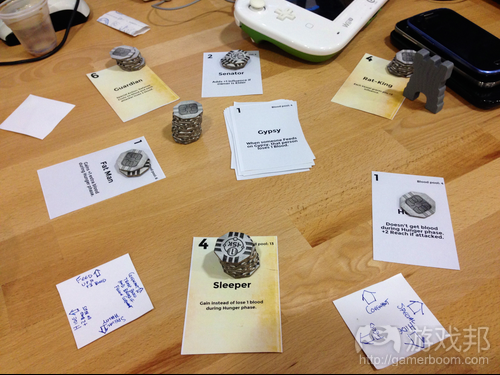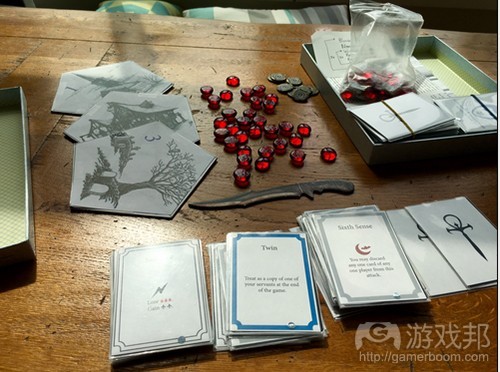作者:Charlie Cleveland
設計一款游戲總是會讓人覺得在尋找屬于自己的游戲。
首先你必須擁有一個理念,然后你要創造一個原型,并嘗試著進行游戲。之后你需要去評估它看看你喜歡其中的什么屬性以及不喜歡什么屬性,并嘗試著總結原因。
你同時還要注意到像別人在玩一張紙牌時臉上所露出的微笑或者他們使用某一道具的方式,再或者他們在YouTube重放時的尖叫等等基于情感且意想不到的結果。這些看似微不足道的元素都可能預示著你的游戲擁有你所不知道但卻非常重要的特征。你可能只能在偶然情況下才會發現它們。而如果你能夠認真觀察,你的下一個游戲原型便能更多地專注于正確的方面而避開那些無用的內容。
就像在吸血鬼游戲中,開始總是非常簡單:我喜歡像《銀河遭遇戰》和《Magic》等非常規游戲,并希望能夠創造一款簡單且適合晚宴的游戲。但結果卻讓我非常吃驚,我希望自己創造的是最終游戲,但似乎原型卻不能作為最終游戲。
所以我便在一個晚上抽出2.5個小時并創造出一款根本不能達到自己目標的游戲。它真的非常糟糕。但它的確是一款完整的游戲,我們在隔天進行了游戲測試。但說實話這款游戲真的就像垃圾一般。
但因為基于非常低的期待值,我能夠暢通無阻且快速地打下所有內容。隔天我打印了規則,并借鑒了來自其它游戲的一些組件。所以這款游戲最終如下圖所示:

first playtest(from gamasutra)
游戲中的主要概念包括:
1.每個玩家都擁有獨特的吸血鬼能力
2.玩家可以利用他們之間的人類
3.每個玩家可以獲取每個人類上的血液
4.每個人可以基于同樣的行動作出同步行動選擇
5.饑餓元素會讓每個玩家在每一輪損失一滴血液,所以他們需要喂飽自己
現在我非常喜歡桌面游戲設計,所以我便致力于開發這樣的游戲。
在經過1年時間投入500個小時于游戲開發后,我創造了8個主要版本以及40朵個較小的修訂內容,如今游戲看來大不一樣了。

ready for publishing submission(from gamasutra)
實際上,游戲中唯一保留了來自最初版本的概念便是每個玩家所獲得的來自人類身上的血液。甚至是每個玩家所擁有的獨特“Cosmic”能力也被刪除了。雖然我盡可能地去挽留了它們,但是最終還是覺得刪除這些內容對游戲來說更好。
但是這是否是創造游戲的有效方式?
這就好像看著自己以前的照片時所涌現出來的矛盾感。
你的朋友會問你:“那是誰?”
你會自信地回答:“是我”。
但從拍下那張照片以來,你身體上的每一個細胞都發生了變化。
當然你還是你,但是你的身體的每一部分卻都發生了改變。不過因為創造出你身體的每一個組件的DNA還是一樣,所以你的身體將繼續將你維持在照片中的狀態。
而游戲設計似乎也是如此。甚至當所有元素都發生改變時,游戲的“精髓”也仍然存在著。
不僅如此,對于我來說擁有所有的這些改變是非常必要的。因為只有這樣你才能清楚自己盡所能“創造”出了最佳游戲。即創造出了值得你所投入的時間并值得玩家去欣賞的游戲。
( 本文為游戲邦/gamerboom.com編譯,拒絕任何不保留版權的轉發,如需轉載請聯系:游戲邦 )
Finding the fun in game design
by Charlie Cleveland
Designing a game often feels like finding your game.
First you have an idea, then you create a prototype (a “hypothesis”) and then you play it. Then you evaluate it to see what attributes you liked and what you didn’t, and try to surmise why.
You also notice subtle emotional and unexpected results, like a smile on someone’s face when they played a card, or how they pantomimed with a prop, or why they screamed during a YouTube playback. These subtle points can indicate important, exciting traits you didn’t know your game had. You just stumbled upon them. And then if you’re listening carefully, your next prototype has focuses more on these good things and less on the bad.
In Vampire game, it started very simply: I loved rule-breaking games like Cosmic Encounter and Magic and wanted to make one that was simpler and suitable for a dinner party. But I was blocked: I wanted this to be the ULTIMATE game, and no prototype is good enough for that.
So I gave myself 2.5 hours in one evening to create a horrible game, one that didn’t have to achieve my goals. It could be total crap. But it had to be a complete game, and one that we would playtest the next day. This is truly designing for the garbage can.
But with such low expectations, I suddenly was on fire and typing as fast I could – I was completely unblocked. The next day, I printed the rules, borrowed some components from other games and played a game. It looked something like this:
First playtest (July 2015)
The main concepts in the game included:
1. A unique vampire power for each player
2. Humans in between each player which could be taken
3. Blood for each player and on each human
4. Simultaneous action selection with the same actions for everyone
5. A hunger element which had every player losing 1 blood per turn so they had to feed.
Now I was excited about board game design, like I always thought I could be. Then I got to work.
After 500 hours of work in a year, 8 major versions and 40 smaller revisions, the game is quite different. In fact, the only concept in the game that remains from the first version is…blood for each player and on each human. Even the founding element of the game, a unique “Cosmic” like power for every player has finally just been thrown out. I held onto it longer than I should have, because it was dear to my heart, but the game is better with the removal.
Ready for publisher submission (September 2016)
But, is this a good, or efficient way to make games?
It makes me think of the apparent paradox when looking at an old picture of yourself.
“Who is this?” your friend asks.
Charlie, age 10. Today I’m still a geek.
“It’s me.”, you reply confidently.
But since that photo was taken, every single cell in your body has been replaced.
You are still you, even though no part of your physical being remains the same. But the DNA that (re)created every piece of you is the same, so your body continues to “make” you in your own perfect image.
It seems to work the same way in game design. The “spirit” of a game can carry through, even when every single other element changes.
Not only that, but to me it actually seems necessary to have all this change. Only then, will you know for sure that you have “created”the best game you can. One that’s truly worth your time, and that of your players.( source:Gamasutra )
Tags: 游戲設計
文章來源:http://gamerboom.com/archives/92939